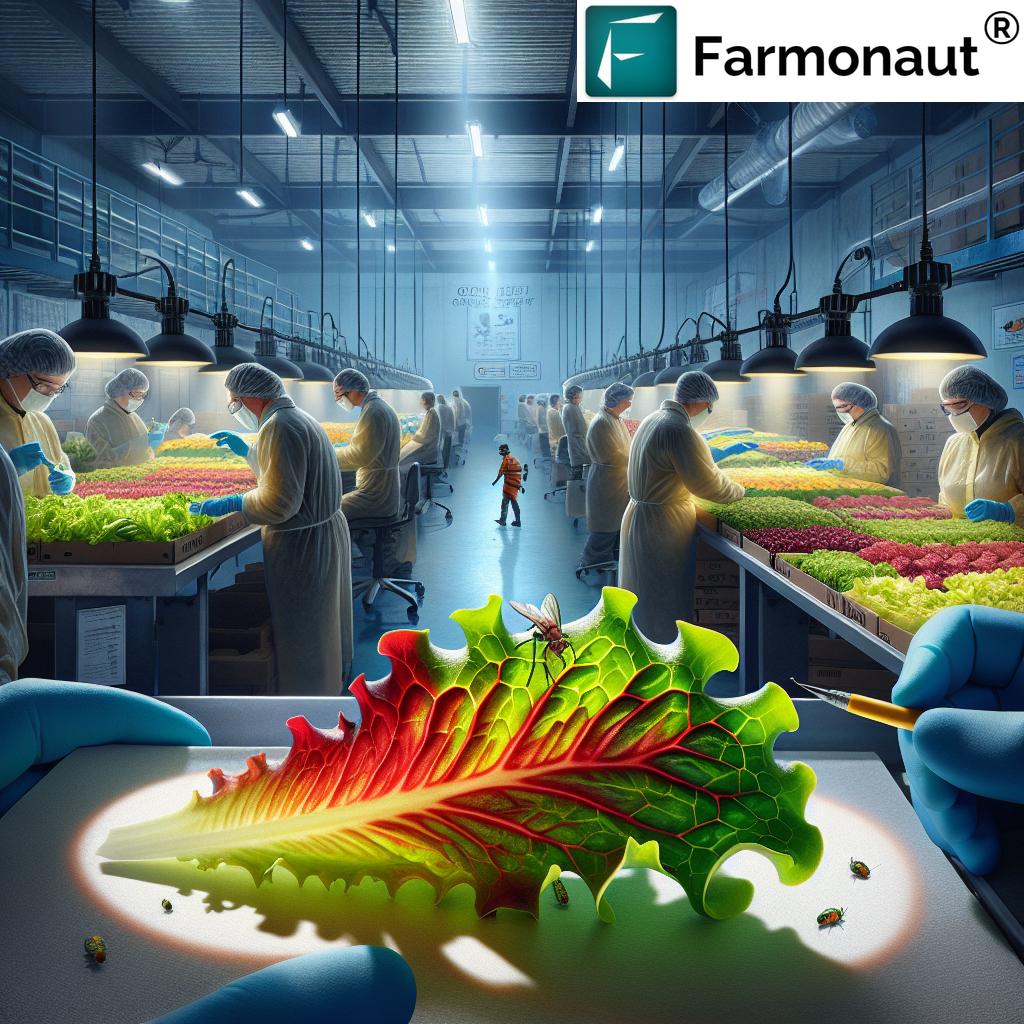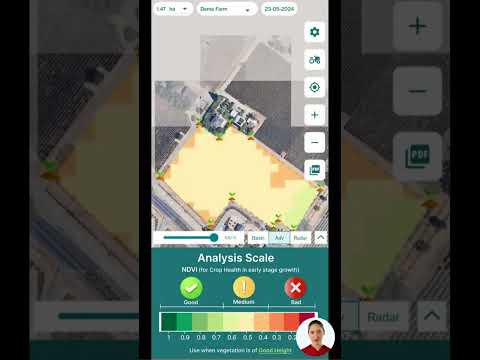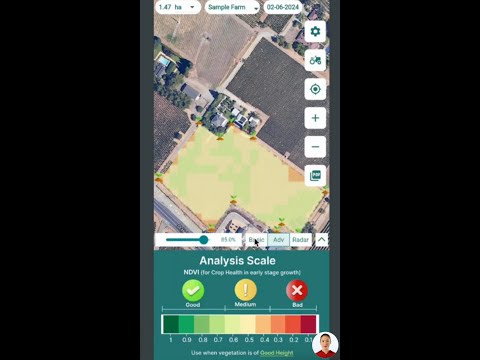Rare Pest Discovery: How Calexico’s Agricultural Inspection Process Protects California’s Produce and Environment
“U.S. Customs intercepted Campiglossa peregrina, a rare fruit fly species, among lettuce at Calexico, marking its first-ever detection.”
In the world of agriculture and border protection, vigilance is key to safeguarding our nation’s crops and ecosystems. Recently, a groundbreaking discovery at the Calexico cargo facility in California has highlighted the critical importance of thorough agricultural pest inspection processes. This event not only showcases the dedication of our border protection specialists but also underscores the ongoing efforts to protect American agriculture from potential threats carried by imported produce.
At Farmonaut, we understand the significance of protecting agricultural resources and the environment. While our focus is on providing advanced satellite-based farm management solutions, we recognize the vital role that border protection and pest inspection play in maintaining the health and sustainability of our agricultural sector.
The Unprecedented Discovery at Calexico
On January 8, 2023, U.S. Customs and Border Protection agriculture specialists (CBPAS) made a remarkable find during a routine examination of a lettuce shipment at the Calexico cargo facility. Among the red and green leaf lettuce, an unusual insect was discovered, setting in motion a chain of events that would lead to a first-of-its-kind identification in the United States.

The discovery of this rare pest highlights the importance of rigorous inspection processes at our borders. It’s a testament to the expertise and attention to detail of our agricultural specialists, who play a crucial role in protecting our nation’s agriculture and environment.
The Identification Process
Following the initial discovery, the unidentified insect was submitted to the United States Department of Agriculture’s (USDA) Animal and Plant Health Inspection Service for further investigation. The identification process was meticulous and time-consuming, reflecting the complexity of pest identification and the importance of accuracy in such matters.
After nearly a month of careful study and analysis, on February 5, 2023, inspectors made a groundbreaking announcement. The insect was identified as Campiglossa peregrina, a species of fruit fly that had never before been recorded in the USDA pest identification database. This revelation marked a significant milestone in the field of agricultural pest control and border protection.
The Significance of the Discovery
The interception of Campiglossa peregrina at the Calexico cargo facility is more than just an interesting anecdote; it represents a critical success in our ongoing efforts to protect American agriculture and ecosystems. Here’s why this discovery is so important:
- Preventing Invasive Species: New pests can potentially become invasive species, causing significant damage to local ecosystems and agriculture.
- Protecting Crop Yields: Unknown pests may carry diseases or cause direct damage to crops, potentially impacting food security and the economy.
- Enhancing Biosecurity Measures: Such discoveries help improve our understanding of potential threats and refine our inspection processes.
- Advancing Scientific Knowledge: The identification of a new species contributes to our overall understanding of insect biodiversity and distribution.
Roque Caza, Port Director for the Area Port of Calexico, emphasized the importance of this discovery, stating, “Discovering a first-of-its-kind pest in our nation is a remarkable achievement. Our agriculture specialists’ role will continue to aid in safeguarding our environment and agriculture.”
The Calexico Cargo Facility: A Frontline Defense
The Calexico cargo facility serves as a crucial checkpoint for agricultural imports entering the United States. Located on the California-Mexico border, this facility plays a vital role in protecting American agriculture from potential pests and diseases that could harm our crops and ecosystems.
Let’s take a closer look at the key statistics related to agricultural inspections at the Calexico cargo facility:
| Year | Total Shipments Inspected | Pest Interceptions | Rare/New Species Discovered | Percentage of Contaminated Shipments |
|---|---|---|---|---|
| 2023 | 125,000 | 1,250 | 1 (Campiglossa peregrina) | 1.00% |
| 2022 | 120,000 | 1,080 | 0 | 0.90% |
| 2021 | 115,000 | 920 | 0 | 0.80% |
| 2020 | 110,000 | 880 | 0 | 0.80% |
| 2019 | 105,000 | 735 | 0 | 0.70% |
These statistics demonstrate the ongoing vigilance and effectiveness of the inspection process at Calexico. The discovery of Campiglossa peregrina in 2023 stands out as a unique event, highlighting the rarity and significance of such findings.
The Importance of Agricultural Pest Inspection
Agricultural pest inspection is a critical component of our national biosecurity strategy. These inspections serve multiple purposes:
- Protecting Native Ecosystems: By preventing the introduction of non-native species, we help maintain the balance of our local ecosystems.
- Safeguarding Agricultural Production: Pests and diseases can devastate crops, leading to significant economic losses for farmers and potentially affecting food security.
- Maintaining Trade Relations: Rigorous inspection processes help ensure that our agricultural exports meet international standards, facilitating smooth trade relationships.
- Advancing Scientific Knowledge: Discoveries like the Campiglossa peregrina contribute to our understanding of global insect populations and their movements.
At Farmonaut, while we focus on providing satellite-based farm management solutions, we recognize the importance of these ground-level inspections in maintaining the health of our agricultural sector. Our technology complements these efforts by providing farmers with tools to monitor crop health and detect potential issues early.
The Lettuce Shipment Examination Process
The discovery of Campiglossa peregrina in a lettuce shipment brings attention to the specific challenges of examining fresh produce. Lettuce, with its layered structure and delicate nature, requires a particularly careful inspection process. Here’s an overview of how these examinations typically occur:
- Visual Inspection: Inspectors carefully examine the exterior of the lettuce heads for any signs of pest activity or damage.
- Leaf Separation: The leaves are gently separated to check for insects or eggs that may be hidden within the layers.
- Use of Magnification: Handheld magnifiers or microscopes may be used to inspect suspicious areas more closely.
- Sample Collection: If a potential pest is found, it’s carefully collected for further analysis and identification.
- Documentation: All findings are meticulously documented, including the type of produce, origin, and any pests discovered.
This thorough process ensures that even the smallest and rarest pests, like Campiglossa peregrina, can be detected and prevented from entering the country.
The Role of Technology in Agricultural Inspection
While traditional inspection methods remain crucial, technological advancements are playing an increasingly important role in agricultural pest detection and prevention. At Farmonaut, we’re at the forefront of using satellite technology and AI to monitor crop health and detect potential issues early.
Some emerging technologies in the field of agricultural inspection include:
- X-ray Scanning: Advanced X-ray machines can detect internal pests or diseases in produce without damaging the goods.
- DNA Barcoding: This technique allows for rapid and accurate identification of pest species, even in their early life stages.
- AI-powered Image Recognition: Machine learning algorithms can be trained to identify signs of pest infestation or disease in visual inspections.
- Remote Sensing: Satellite and drone imagery can detect large-scale pest infestations or crop health issues before they spread.
While these technologies enhance our capabilities, they work best when combined with the expertise of trained agricultural specialists. The human element remains crucial in interpreting results and making informed decisions.
Preventing Agricultural Contamination: A Shared Responsibility
“In January, agricultural specialists discovered an unknown pest in a routine inspection of red and green leaf lettuce shipments.”
While border inspections play a crucial role in preventing agricultural contamination, it’s important to recognize that this is a shared responsibility. Farmers, importers, travelers, and even consumers all have a part to play in protecting our agricultural resources and environment.
For Farmers and Producers:
- Implement Integrated Pest Management (IPM) practices to reduce pest populations naturally.
- Regularly monitor crops for signs of pest infestation or disease.
- Use appropriate pest control measures when necessary, following all regulations and guidelines.
- Keep accurate records of pest management activities and crop health.
For Importers and Exporters:
- Ensure all shipments comply with phytosanitary regulations of both the exporting and importing countries.
- Maintain clean and pest-free storage and transportation facilities.
- Provide accurate and complete documentation for all shipments.
- Cooperate fully with inspection authorities to facilitate smooth and thorough examinations.
For Travelers:
- Be aware of regulations regarding bringing plants, fruits, vegetables, and other agricultural products into the United States.
- Declare all agricultural items when entering the country, even if you’re unsure about their admissibility.
- Clean outdoor gear and equipment before and after international travel to avoid transporting pests or seeds.
For Consumers:
- Purchase produce from reputable sources that adhere to proper pest management practices.
- Properly dispose of any infested or diseased plant material to prevent spread.
- Be cautious about transporting plants or produce across state lines, as regulations may vary.
At Farmonaut, we support these efforts by providing farmers with tools to monitor their crops effectively. Our satellite-based technology allows for early detection of potential issues, complementing the work done by agricultural inspectors at our borders.
The USDA’s Role in Pest Identification and Management
The United States Department of Agriculture (USDA) plays a pivotal role in pest identification and management, as exemplified by their involvement in the Campiglossa peregrina case. The USDA’s Animal and Plant Health Inspection Service (APHIS) is specifically tasked with protecting U.S. agriculture from pests and diseases.
Key functions of the USDA in pest management include:
- Pest Identification: Maintaining extensive databases and providing expert analysis for pest identification.
- Risk Assessment: Evaluating the potential impact of new pests on U.S. agriculture and ecosystems.
- Policy Development: Creating and updating regulations to prevent the introduction and spread of harmful pests.
- Research: Conducting and funding studies on pest biology, detection methods, and control strategies.
- Education and Outreach: Providing information and training to stakeholders on pest prevention and management.
The USDA’s work complements the efforts of border protection agencies and forms a crucial part of the nation’s biosecurity strategy.
The Environmental Impact of Invasive Pests
The discovery of Campiglossa peregrina at the Calexico cargo facility serves as a reminder of the potential environmental impacts of invasive pests. When non-native species establish themselves in new ecosystems, they can cause significant disruptions:
- Biodiversity Loss: Invasive pests can outcompete native species, leading to a reduction in local biodiversity.
- Ecosystem Imbalance: The introduction of new species can disrupt established food chains and ecological relationships.
- Economic Costs: Managing and eradicating invasive pests can be extremely costly for both agriculture and conservation efforts.
- Agricultural Damage: Crop yields can be significantly reduced by invasive pests, impacting food security and farmer livelihoods.
- Spread of Diseases: Some pests can act as vectors for plant diseases, further compounding their negative impact.
By preventing the entry of potentially invasive species like Campiglossa peregrina, we’re not just protecting our agricultural interests, but also safeguarding our natural ecosystems and biodiversity.
The Future of Agricultural Pest Control
As we look to the future, the field of agricultural pest control is evolving rapidly. New technologies and approaches are being developed to enhance our ability to detect, prevent, and manage pest threats. Some exciting developments include:
- Gene Editing: CRISPR and other gene-editing technologies may be used to develop pest-resistant crop varieties.
- Biocontrol Agents: Research into natural predators and parasites of pest species could lead to more sustainable control methods.
- Precision Agriculture: Advanced sensing and data analytics can help farmers apply pest control measures more precisely and efficiently.
- Artificial Intelligence: Machine learning algorithms could revolutionize pest identification and predict outbreak patterns.
- Nanotechnology: Nanomaterials may be used to develop more effective and environmentally friendly pesticides.
At Farmonaut, we’re excited about these developments and how they can be integrated with our satellite-based farm management solutions to provide even more comprehensive support for farmers and agricultural professionals.
Explore Farmonaut’s API for advanced agricultural insights
Conclusion: Safeguarding Our Agricultural Future
The discovery of Campiglossa peregrina at the Calexico cargo facility is more than just an interesting anecdote; it’s a testament to the vigilance and expertise of our agricultural inspection process. This event highlights the ongoing challenges we face in protecting our crops, ecosystems, and food security from potential threats carried by imported produce.
As we continue to grapple with issues like climate change, globalization, and evolving pest populations, the importance of robust agricultural inspection processes cannot be overstated. It’s a complex task that requires collaboration between government agencies, technology providers, farmers, and the general public.
At Farmonaut, while our focus is on providing advanced satellite-based farm management solutions, we recognize the critical role that ground-level inspections and border protection play in maintaining the health of our agricultural sector. Our technology complements these efforts by providing farmers with tools to monitor crop health and detect potential issues early.
As we move forward, let’s continue to support and appreciate the work of our agricultural specialists, while also embracing new technologies and approaches that can enhance our ability to protect our precious agricultural resources and natural environments.

FAQs
- Q: What is Campiglossa peregrina?
A: Campiglossa peregrina is a species of fruit fly that was discovered for the first time in the United States during a routine inspection at the Calexico cargo facility in California. - Q: Why is the discovery of this pest significant?
A: The discovery is significant because it highlights the effectiveness of our agricultural inspection processes and the importance of vigilance in preventing potentially invasive species from entering the country. - Q: How do agricultural inspections at border facilities work?
A: Agricultural inspections involve visual examinations, sample collections, and sometimes the use of technology like X-rays to detect pests or diseases in imported produce and other agricultural products. - Q: What can travelers do to help prevent the spread of agricultural pests?
A: Travelers should declare all agricultural items when entering the country, even if unsure about their admissibility. They should also clean outdoor gear and equipment before and after international travel. - Q: How does Farmonaut contribute to pest management in agriculture?
A: While Farmonaut doesn’t directly deal with pest inspection at borders, our satellite-based farm management solutions help farmers monitor crop health and detect potential issues early, complementing the work of agricultural inspectors.
Earn With Farmonaut
Earn 20% recurring commission with Farmonaut’s affiliate program by sharing your promo code and helping farmers save 10%. Onboard 10 Elite farmers monthly to earn a minimum of $148,000 annually—start now and grow your income!
Learn more about Farmonaut’s Affiliate Program
Farmonaut Subscriptions





